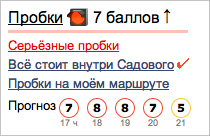Traffic jams from the future
As users from Moscow could notice, today a new informer has appeared on the Yandex main page - a traffic jams prediction score. It is designed to help motorists plan their movements.

It appears when at least once in the next five hours is expected three or more points. The readings are updated every 10 minutes. This functionality, like many, was born from a hypothesis - evening traffic jams directly depend on the day of the week, month and morning traffic jams, because most of those who came to the center will have to come back.
')
To test the hypothesis, we decided to use a neural network. If it is simple, then the neural network is a kind of “black box” to which you set known factors and conditions, and it processes them and gives the solution to the problem. More serious definitions can be found in dictionaries . Such networks are used, for example, to distribute web traffic between servers or control city traffic lights.
For the experiment, we took the publicly accessible library of artificial neural networks FANN . We trained the network with the help of the two-year Yandex.Probok archive and got the first results. After comparing the forecast with reality, it became clear that the hypothesis was confirmed. And then the conversation turned to the weather. But not because all topics are exhausted.
It's no secret that precipitation affects the traffic situation in the city. If it rains or snows, drivers are in trouble. We took a weather archive and retrained networks based on data on precipitation, temperature and pressure changes over two years. By the way, in the process of studying the prediction of a point, we noticed one surprising fact at first glance.
Information on whether precipitation falls or not affects the forecast accuracy much less than the number of millimeters of mercury and degrees Celsius. What, in fact, is logical, because precipitation depends on these two indicators, and the indicators themselves are much more accurate than “rain is possible in some places”.
After adding the weather data, the forecast accuracy improved, and we thought about the product itself. Initially, we were going to predict only evening traffic jams in the morning. But then they thought it was too narrow. And they decided to predict the whole day - from the morning and five hours ahead.
To reduce the likelihood of error, we calculate the forecast in three independent neural networks at once, which were trained separately from each other. The main page displays a rounded arithmetic average of their results.
Of course, this informer is not an accurate measuring device. It shows in which direction the situation will develop. The probability of predicting a score in a score now varies on average from 60 to 77% - guessing is better the closer the future is to the present.

It appears when at least once in the next five hours is expected three or more points. The readings are updated every 10 minutes. This functionality, like many, was born from a hypothesis - evening traffic jams directly depend on the day of the week, month and morning traffic jams, because most of those who came to the center will have to come back.
')
To test the hypothesis, we decided to use a neural network. If it is simple, then the neural network is a kind of “black box” to which you set known factors and conditions, and it processes them and gives the solution to the problem. More serious definitions can be found in dictionaries . Such networks are used, for example, to distribute web traffic between servers or control city traffic lights.
For the experiment, we took the publicly accessible library of artificial neural networks FANN . We trained the network with the help of the two-year Yandex.Probok archive and got the first results. After comparing the forecast with reality, it became clear that the hypothesis was confirmed. And then the conversation turned to the weather. But not because all topics are exhausted.
It's no secret that precipitation affects the traffic situation in the city. If it rains or snows, drivers are in trouble. We took a weather archive and retrained networks based on data on precipitation, temperature and pressure changes over two years. By the way, in the process of studying the prediction of a point, we noticed one surprising fact at first glance.
Information on whether precipitation falls or not affects the forecast accuracy much less than the number of millimeters of mercury and degrees Celsius. What, in fact, is logical, because precipitation depends on these two indicators, and the indicators themselves are much more accurate than “rain is possible in some places”.
After adding the weather data, the forecast accuracy improved, and we thought about the product itself. Initially, we were going to predict only evening traffic jams in the morning. But then they thought it was too narrow. And they decided to predict the whole day - from the morning and five hours ahead.
To reduce the likelihood of error, we calculate the forecast in three independent neural networks at once, which were trained separately from each other. The main page displays a rounded arithmetic average of their results.
Of course, this informer is not an accurate measuring device. It shows in which direction the situation will develop. The probability of predicting a score in a score now varies on average from 60 to 77% - guessing is better the closer the future is to the present.
Source: https://habr.com/ru/post/161611/
All Articles